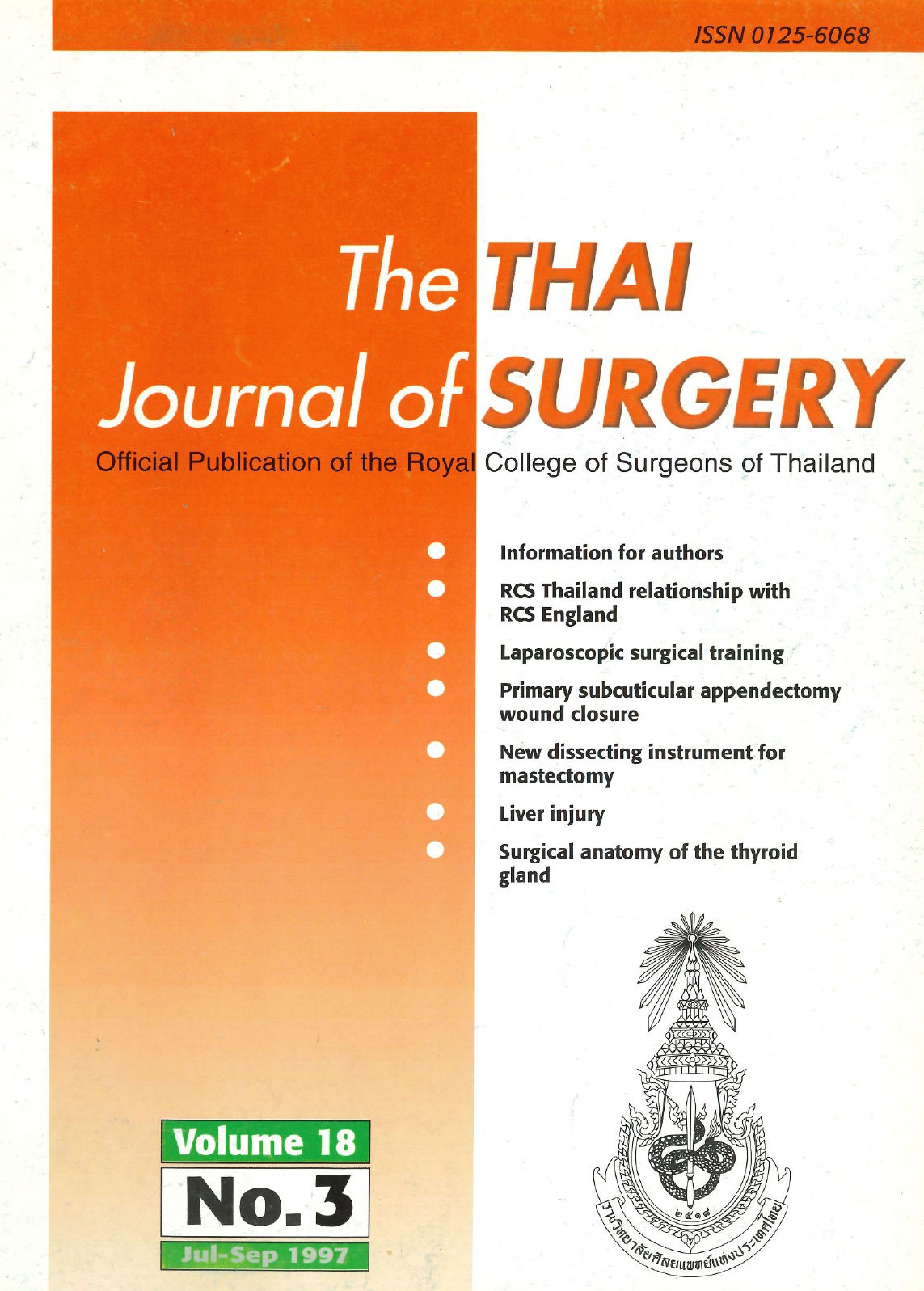Primary Subcuticular Appendectomy Wound Closure in Children: Results of a Prospective Clinical Trial
Keywords:
Appendicitis, Wound infection, Skin closureAbstract
Problem: The standard closure of appendectomy wound using interrupted mattress technique with non-absorbable suture in acute appendicitis and delayed primary closure in ruptured appendicitis seems to be unpractical in children. Such procedure results in unsight wound and may be an unpleasant experience for both patients and surgeons during stitching off the sutures and dressing of the wound.
Objective: To study the risk of wound infection after subcuticular wound closure primarily in children with appendicitis and compare with those who had standard closure.
Setting: Division of Pediatric Surgery, Department of Surgery,
Chulalongkorn University Hospital, Bangkok, Thailand
Research design: Prospective clinical trial
Patients & Method: All children with the diagnosis of appendicitis between January 1991 and June 1997 were included in the study. Primary subcuticular suturing technique using absorbable suture was applied for both acute non-ruptured and ruptured appendicitis in group. Interrupted non-absorbable suturing was applied for acute non-ruptured and delayed primary closure was applied for ruptured appendicitis in another group as a controlled one.
Results: Of 915 patients with clinically diagnosed as appendicitis, 728 children were confirmed by clinical finding and pathological report as acute non-ruptured and 134 as ruptured appendicitis while 48 had normal appendix and 5 had other diagnosis. 587 patients underwent primary wound closure in subcuticular fashion with 5-0 Polyglactin suture while as 268 patients had interrupted 5-0 Nylon suture and 40 patients were managed by delayed primary wound closure. In the study group, postoperative wound infections occurred in 6 of 460 (1.30%) cases with acute non-ruptured appendicitis and 5 of 94 (5.32%) cases with ruptured appendicitis. In the controlled group, 4 in 268 (1.49%) of non-ruptured and 2 in 40 (5%) of ruptured appendicitis got wound infection.
Conclusion: There is no significant difference in the rate of wound infection in the group of acute non-perforated and perforated appendicitis using different wound closure. So, subcuticular appendectomy wound closure using absorbable suture is advised and should be accepted as a standard technique in children.
References
2. Harrison MW, Linder DJ, Campbell JR, et al. Acute appendicitis in children: Factors affecting morbidity. Am J Surg 1984; 147: 605-10
3. Neilson IR, Laberge JM, Nguyen LT, et al. Appendicitis in children: Current therapeutic recommendations. J Pediatr Surg 1990: 25: 1113-6
4. Wetter LA, Dinneen MD, Levitt MD, et al. Controlled trial of polyglycolic acid versus catgut and nylon for appendicectomy wound closure. Br J Surg 1991; 78:985-7
5. Pickford IR, Brennan SS, Evans M, Pollock AV. Two methods of skin closure in abdominal operations: a controlled clinical trial. Br J Surg 1983; 7O: 226-8
6. Krukowski ZH, Irwin ST, Denholm S, Matheson NA, Preventing wound infection after appendicectomy: a review. Br J Surg 1988; 75: 1023-33
7. Foster GE, Hardy EG, Hardcastle JD. Subcuticular suturing after appendicectomy. Lancet 1977; i: 1128-9
8. Serour F, Efrati Y, Klin B, et al. Subcuticular skin closure as a standard approach to emergency appendectomy in children: prospective clinical trial. World J Surg 1996; 20: 38-42
9. Cruse PJE, Foord R. A five-year prospective study of 23,649 surgical wounds. Arch Surg 1973; 107:
206-10
10. Engstrom L, Fenyo G. Appendicectomy: assessment of stump invagination versus simple ligation: a prospective, randomized trial. Br J Surg 1985; 72: 971-2
11. Bower RJ, Bell MJ, Ternberg JL Controversial aspects of appendicitis management in children. Arch Surg 1987;: 122:691-6
12. Janik JS, Firor HV. Pediatric appendicitis: a 20 year study of 1,640 children at Cook County (llinois) Hospital. Arch Surg 1979; 114: 71
Downloads
Published
How to Cite
Issue
Section
License
Articles must be contributed solely to The Thai Journal of Surgery and when published become the property of the Royal College of Surgeons of Thailand. The Royal College of Surgeons of Thailand reserves copyright on all published materials and such materials may not be reproduced in any form without the written permission.



